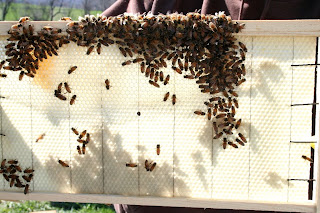DAY 1 IN MY FIRST YEAR WITH HONEY BEES On Friday, April 3, I drove down to North Carolina and picked up my package of bees at Miller Bee Supply. About 4:00 p.m. on a cloudy and rapidly cooling off afternoon, my mentor installed the bees for me (thankfully since I was a nervous wreck at that point). I watched mostly while my husband took these photos.
My mentor first opened up the hive and removed 3 frames in the middle.

He sprayed the package with sugar syrup (1:1) to keep the bees from flying and to calm them down.
He took the syrup can out, then hit the package on the ground so the bees would go down to the bottom. He then just dumped the bees in the middle of the hive, shaking the package from side to side to get most of the bees out.

He put back 2 frames, setting them down on the bees and gently pushing them aside so the frames would set down. You can see the two frames on the side are filled with fresh wired, beeswax foundation.
The queen came in a plastic cage separate from the rest of the bees. I kept her in my pocket to keep her and her attendant warm on the drive up from North Carolina. The little cork in the cage is removed to reveal a small piece of candy which the bees will eat to release the queen.

Here, my mentor is trying to hang the cage on the empty space where the missing frame is. We ended up using a toothpick to hang the cage. Notice how he isn't using a veil or gloves while I've got the bee jacket with veil on!
I was pleased with the package of bees from Miller--only a couple of bees were dead, a lot fewer than I expected. The bees and queen were raised locally and had been packaged the previous day so that might be why there was so little mortality. So, I figure I have started with 12,000 bees.
Friday night, the temperature was down in the low 40s. I went out with a flashlight after dark and saw there were still two "balls" of bees in the package outside the hive so I was worried they might freeze.
I also worried about the queen because she was just introduced that afternoon to the bees. She was in such a little cage that I worried that the bees would eat the candy quickly and kill the queen because they hadn't gotten used to her. But, I can't check on her until the 3rd or 4th day I read so I will observe the bees' behavior, perhaps that will give me clues of their acceptance of the queen .
DAY 2 Saturday morning I attended a great outdoor bee class with Dr. Fell from Virginia Tech (photos and text in this
post). After some shopping (more sugar!), I checked on my bees. My husband had used the veil I bought him and had checked on them several times. He said they took awhile to stir but gradually came out. The ones in the package survived the night fine and were gradually coming out.

The bees had already drank about 1/3 of the quart of sugar syrup. Bees were out and about, some seem to be defending the hive from a few wasps. I did see one bee kill another one.

This drone, male bee, is hanging on the deer netting I am using as a temporary fence. I can tell he's a drone by his large size and the fact that his large eyes are on the top of his head (all the better to see the queen flying above.) These large bees don't do anything but mate with the queen so the female bees do all the work. Of course, my queen is already mated so he doesn't have anything to do.
DAY 3 My husband put the package on the side early this morning since all the bees have left the package.

By 11:30 a.m, lots of bees were on the front, buzzing a lot. They seemed very defensive so I did not get very close to take this picture (and with my veil on!). I hope this is normal behavior. I had also decreased the size of the entrance opening to about 2"

I put my dwarf lemon tree outside which has been blooming for over all month. Within a few minutes, a bumble bee and honey bee were on it! By the time I took this picture, only this yellow jacket? was on the fragrant blossoms.
Since I posted earlier, I observed honey bees on the wildflower toothwort in the woods as well as on a sweet cherry tree. That tree was covered with blossoms so I think they will have plenty to eat for a while.



































